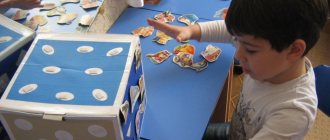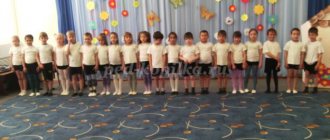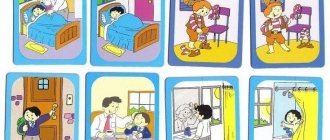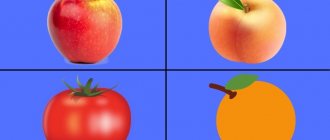Progress of the game:
children (2 people)
take turns taking
a picture , calling what is drawn on it
, determining when it happens. If in the fall , put the picture on the playing field
If at other times of the year, they put it aside. Next, for each picture, make up
sentence using the keyword " autumn "
.
Note: the game can be individual.
Didactic game “Wonderful bag”
.
Objectives: to improve the ability to identify a fruit or vegetable by touch by its shape,
correctly name its color, develop attention, memory, oral speech
Attributes: bag, dummies of vegetables and fruits.
Didactic game "Autumn"
Didactic game “Number. Sign. Subject" on the lexical topic "Autumn"
The game is intended for children aged 4-6 years with severe speech impairments, as well as for children of preschool and primary school age to develop the lexical and grammatical structure of speech.
Didactic game “Number. Sign. Subject" can be used both in individual and subgroup lessons with children.
Target:
This set of games will help an adult teach a child:
- agree nouns with numerals and adjectives in gender, number, and case.
- select qualitative, relative, possessive adjectives for nouns.
- use ordinal numbers in speech, coordinate them with nouns and adjectives in gender, number, case.
- activate mental activity, associative thinking;
- make comparative sentences with the conjunction “a”.
Material for the game:
cards with game tasks in two subjects of the same lexical group; playing field and cut cards for independent selection and compilation of a plot series; sets of numbers.
Game description:
Game with ready-made models: each table contains tasks for two subjects of the same lexical group for a larger educational load. At the beginning of the game, the child needs to be clearly shown how associations can be used to indicate the characteristics of objects. For example, how can you depict a bitter taste, show the hardness, softness, juiciness of vegetables, color and shape.
Below are ready-made game cards:
- two oval deep puddles;
- six large cold drops;
- one round cold sun;
- five short cold autumn days;
- two autumn cold rains;
- seven autumn cold winds;
- one autumn mahogany;
- four autumn blue clouds.
The game requires compliance with the following steps:
- Name a word denoting a number (what number? - one).
- Name a word denoting an object (what is it? - tree).
- Agree the noun with the numeral in gender (how many trees? - three is one).
- Name the words denoting the attribute of an object, coordinate them with numerals and nouns in gender, number (one tree (which?) - red in autumn).
- Agree the numeral with the adjectives and nouns in gender and number. (Say in a complete sentence, starting with a number. – One autumn red tree.)
- Using the same principle, consider another subject of the lexical group - a cloud.
- Make comparative sentences with the conjunction “a”. (There is one tree, and there are four clouds. The tree is red, and the cloud is blue.)
Game with cut cards : played on the same principle as with ready-made models. Only here the child takes an active position and is given more independence.
First, you should invite the child to choose an item on a lexical topic and place it in a sector with an asterisk, then a number (place in the first sector) and select adjectives in the form of picture symbols (place in the longest sector of the playing field). The symbol pictures are first reviewed and what they mean is explained.
To better understand the progress of the game with cut cards, a sample is provided below.
Using the didactic game “Number. Sign. Subject" children will quickly master the skills of agreeing adjectives, nouns and numerals in gender, number, case; will learn to select adjectives for nouns and develop their associative thinking.
The development of associative thinking has a positive effect on the process of memorizing and reproducing necessary information.
On our website you can find other educational games from the “Number” series. Sign. Item". To do this, follow the highlighted link .
We wish everyone success.
Game "Autumn Gifts"
What the child will learn: distinguish between leaves, cones, nuts and acorns; use the words “more”, “one” in speech.
Equipment: tray, 4 saucers.
Progress of the game:
in late summer or early autumn, while walking with your child, invite him to collect a bouquet of leaves; collect cones, acorns or nuts in a basket.
Having brought these finds (3-4 pieces each) home, prepare to play with your child: put everything on a tray, carefully place it on it, and dry it.
Invite your child to put what he has collected into separate saucers, while commenting on the child’s actions: “Put the nut. Add another nut." (Ask your child to repeat after you: “Here’s another nut... Here’s another nut...”)
Continue: “Put the acorn here. Another acorn. And one more acorn...” Help the child arrange the cones and leaves.
Game "Treats"
What the child will learn:
correctly use masculine and feminine singular nouns in the accusative case without a preposition; answer questions that require a comparison of facts and a simple conclusion.
Equipment:
toys - hare, bear, squirrel; subject pictures.
Progress of the game:
Tell your child that today a bunny, a bear and a squirrel came to visit him. Offer to treat them to something tasty - something they love.
Place a carrot, cabbage, pine cone, acorn, pear, plum in front of the child. Ask: “What does the bunny like? What does the bear like? What does a squirrel like? What should we give the bunny? What should we give the bear? What should we give the squirrel? (For the bunny - carrots, cabbage. For the bear - a pear, plum. For the squirrel - a pine cone, an acorn.)
Why didn't the bunny get a bump? (Because he doesn't eat pine cones.)
Why did they give the bunny a carrot? (Because he loves carrots.)
Game "We are at the dacha"
What the child will learn:
see the difference between grass - trees - bushes; recognize their images; highlight branches and leaves of a tree; distinguish between the verbs “cuts - digs up”; understand simple stories; listen to an adult's story.
Equipment:
story picture.
Progress
of the game:
in early autumn, while walking with your child in the country (or in a park, square), start talking with him about what you see around him. Ask your child to show you a tree, bushes, grass.
If the child finds it difficult to do this, show him yourself; after a while, ask again to check how he understood and remembered what was shown. If the child
says a word, for example, “branch”, ask: “Where is the branch?” Constantly try to encourage your child's desire to talk.
After the orientation walk, look at the picture with your child. It depicts approximately what the child saw while walking around the dacha. Ask your child who is in the picture? (boy and girl). Invite your child to come up with names for a boy and a girl. (Try to choose names that consist of two identical syllables, for example Tata, Lyalya, or from different syllables, but with emphasis on the first syllable, for example: Nina, Nata, Tolya, etc.) Tell us what the boy is wearing ( jacket, boots, trousers), on the girl (scarf, jacket, skirt). Then offer to show it to him. Tell us that the girl is cutting flowers; that the boy is digging up potatoes.
Ask your child to show trees, bushes, grass, and flowers in the drawing. Tell your child: “You see, the wind is blowing dried leaves, shaking tree branches, windows are slamming from the wind, laundry is swinging on a line.”
Emotionally say: “The wind is blowing, blowing, blowing, blowing, tearing yellow leaves from the tree. The leaves are falling right under our feet.” Ask how the wind is blowing (“oooh”). Offer to draw a line with a pencil from one tree to another of the same kind; from one bush to another the same.
Game “Put it where I say”
What the child will learn:
distinguish prepositions expressing certain spatial relationships between two objects (on, in).
Equipment:
book, box, pieces of furniture (table, chair, sofa); any object (acorn, leaf, pebble).
Progress of the game:
Place the item you have chosen in front of your child. Ask the child to put this object where you say: on a book, on a table; on a chair; in a box, in a book.







